
Rover P6 Design Innovations
as published in British V8 Newsletter, Volume XV Issue 3, December 2007
by: Bill Wardlow of The Motorway Ltd.
When the Rover 3500S debuted in North America, I was already working on P6 models.
I had a job in a Rover / Land Rover dealership in northern New Jersey. In fact,
I was driving a beautiful '67 2000TC which I'd bought for $600.00 with a blown
2nd gear. As I recall, $60.00 worth of parts put me on the road in a car which
otherwise would have been financially out of the question for me. So you see, I
came to appreciate the P6 design before there was a V8 in the picture. Its other
design features, many with an eye toward safety, have left a more permanent mark
on me than has the aluminum powerplant. I shall touch only lightly on them here.
A book could be written.
Although the photos shown here are of later V8 ("3500S") version of the P6 platform, almost all of the features shown and discussed were available to the car buying public from 1964 in the smaller-engined "2000" series models.
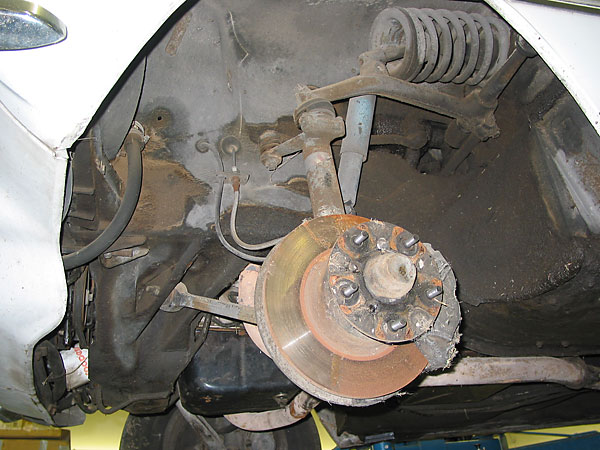
Left front suspension... and in the background: the extremely-robust front crossmember.
Notice how the "rocker" transfers verticle wheel motion into fore and aft spring travel. Also note how the shock absorber actually extends on bump instead of compressing. (This is favorable in terms of shock absorber longevity.) If you look at the horizontal axis of the rocker in its bushings, and look below the inner one, you'll see the mount for the anti-roll bar. The bar itself is a straight hexagonal piece which you can see disappearing into the engine bay.
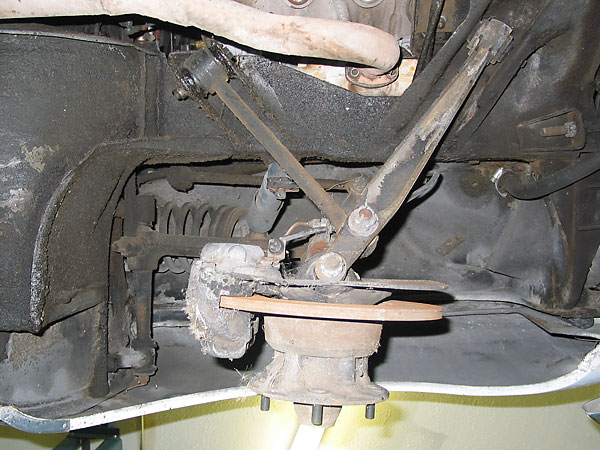
Forged suspension links instead of formed sheetmetal. For its day, the 3-piston brake caliper was massive.
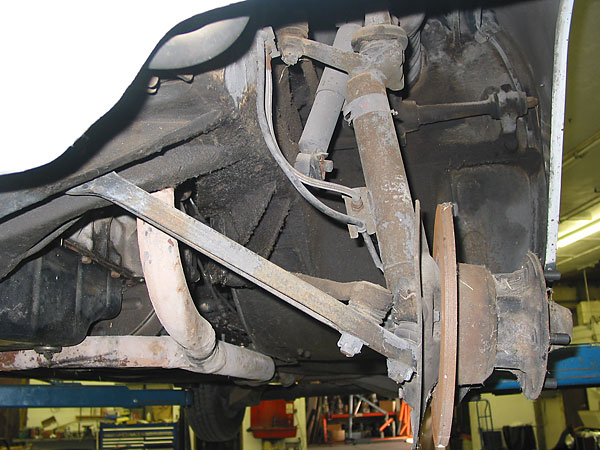
Another interesting feature is that the brake pads had integral electrical wear sensors,
starting with 1969 model year cars. The wiring appears here as a "second brake line".
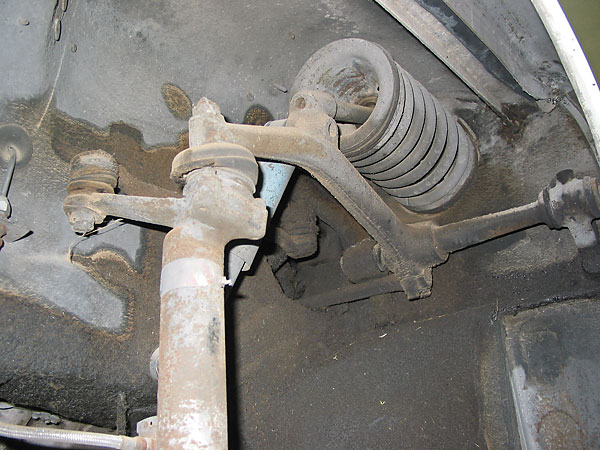
Strong stuff! Big, serviceable ball joints.
Why did the car have such an unusual front suspension design? One reason that's
often reported is Rover had maximized engine compartment packaging space in anticipation
that one day they might install their turbine engines. Whether there's any merit to
this suggestion is immaterial - the unusual front suspension provided tangible technical
benefits of its own. The most important benefit was superior crashworthiness; it kept
frontal impact force from causing cabin intrusion at a time when frontal impacts usually
shoved steering columns like a spear toward the driver.
The P6 steering box is located just barely forward of the firewall, with the track rod
running behind the engine to a bell-crank relay, and thus forward to the steering arms
on the "swivel pillars". To comply with the federal "Safety Act of 1966", other automobile
manufacturers were obliged to install collapsible steering columns. Rover was exempt
from this mandate because their design already provided the same benefit.
The P6 was also one of the first automobile platforms with its engine mounts designed
to direct the engine and gearbox downward, underneath the vehicle, upon impact. This
may seem elementary now, but if you recall seeing wrecks of 50's and early 60's cars,
you may remember seeing engines sitting in front seats.
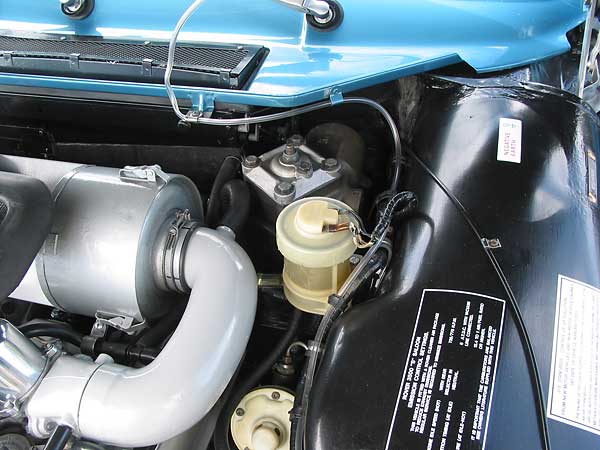
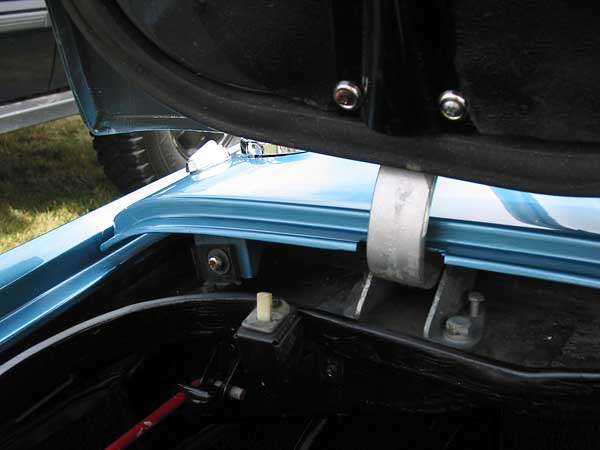
Lance LaCerte's excellent restored Rover 3500S
is fully documented in its own article.
The whole P6 platform, in fact, is one strong unit! It's more rigid under torsional loading than virtually any production sedan before it. The "base unit" of the P6 was constructed as one solidly-welded monocoque structure with integral roll cage. It is possible to remove every body panel from one of these cars, including even the roof sheet metal, and still have an operating car with a complete cabin structure!
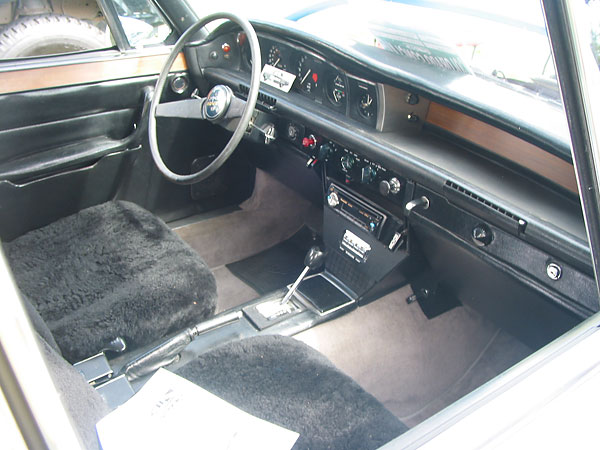
Ergonomically designed interior.
When these cars first came out, they had fixed length (separately adjustable) lap and shoulder belts. Once you were in and belted-up there was no moving around. It was not a problem because every instrument and control needed for driving was within easy reach. The controls were laid out logically and intuitively. We could use some of that in today's cars! I really enjoyed the security of those belts. (They were very like a race car.)
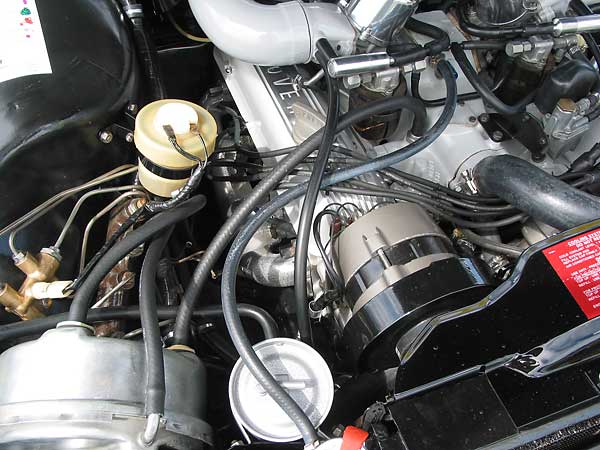
Four wheel disc brakes with booster. The system was well tuned and provided excellent modulation.
There are many cars in production today that don't measure up in terms of brake balance and feel.
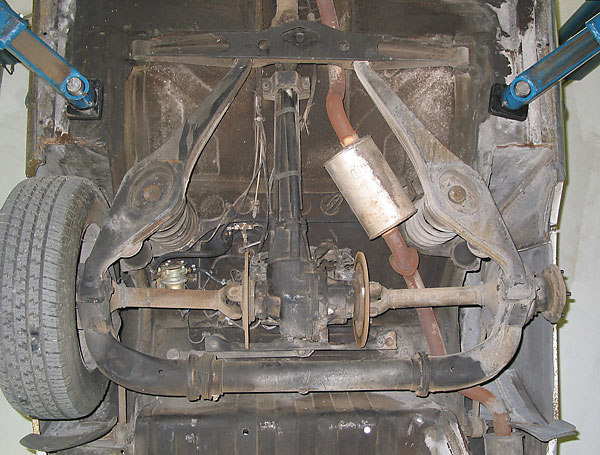
Modified DeDion rear suspension. (Front of car is toward top of the picture.)
Although articles have been written over the years about the P6's unique "modified
DeDion type" rear suspension, Many of the descriptions of it have been incomplete or
just plain wrong. To launch into a complete discussion of its features and properties
here would be beyond the scope of this article. Suffice it to say that the P6 suspension
is unusually compliant, very steady, and that road-holding on irregular surfaces
remains among the best I've driven. A brief overview of system components will provide
a little insight.
The main "DeDion tube" is the straight section across the bottom of the photo.
The "elbow" to the right is rigidly attached to that tube and also houses one wheel hub.
The elbow to the left is bolted to the opposite wheel hub and also to a smaller diameter
straight tube which rides on bronze bushings inside the larger tube. It therefore is free
to both plunge and swivel. The axes of the two tubes always remain colinear, so the
two wheel hubs remain nominally parallel.
Enjoying this article? Our magazine is funded through the generous support of readers like you!
To contribute to our operating budget, please click here and follow the instructions.
(Suggested contribution is twenty bucks per year. Feel free to give more!)
(Note: the fuel tank is mounted above the differential, behind the rear seats, which is the safest place for it! If the car is rear-ended, there's a generously-sized crush zone between the rear bumper and fuel.)
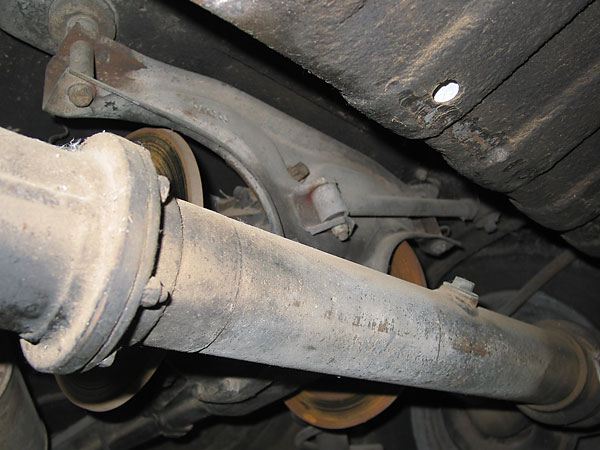
The DeDion tube has an oil filler plug for lubricating the bronze bushings. Note also that the
differential housing is on rubber mounts, with a torque rod to restrict side-to-side motion.
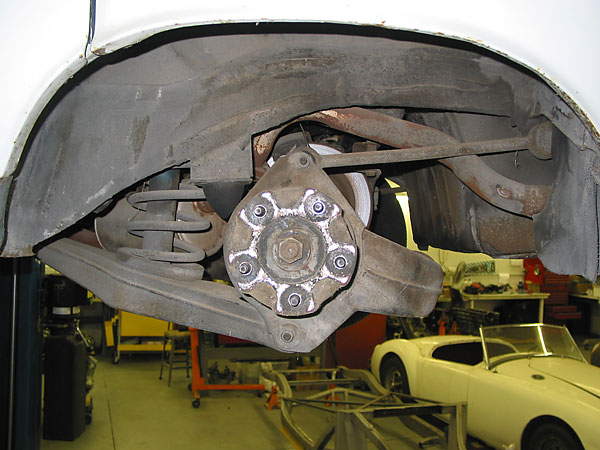
The lower & upper arms shown here function as a "Watts linkage" to locate the hub fore and aft.
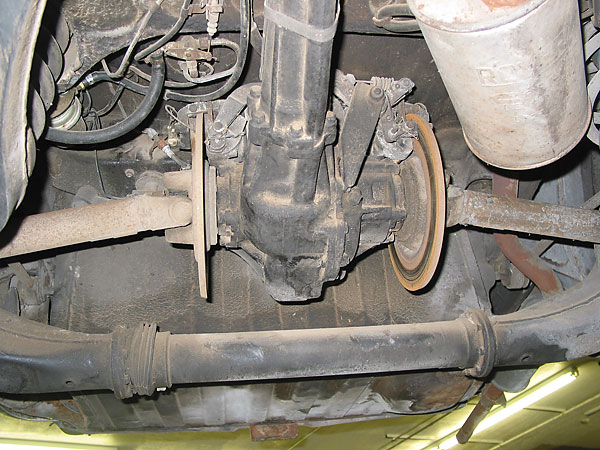
Inboard-mounted rear disc brakes.
The inboard brake calipers are hydraulic, but they also include a cable-operated lever mechanism to engage the emergency brake. This was a very modern feature for its day, and an important one too. This was a true emergency brake, with enough grip to stop the car from speed. (It wasn't just a parking brake! Many of today's cars use a small, seperate brake drum inside the bell of the rotor, or a small secondary brake caliper. These designs typically provide less braking capability to the hand-brake lever.)
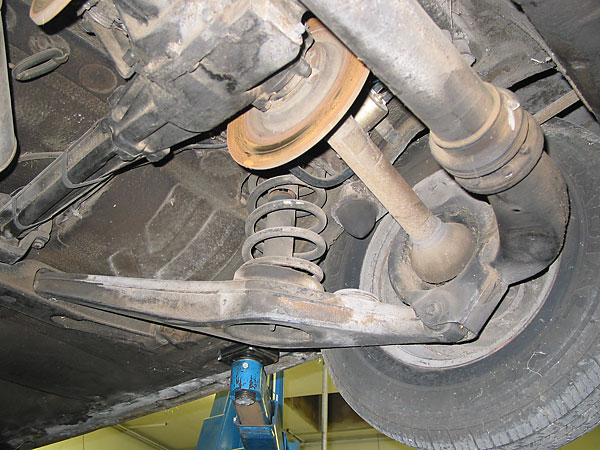
Springs with concentric shock absorbers.
The Rover P6 suspension used fixed-length half shafts. Underneath the rubber boots that are visible in this photo, you would find conventional U-joints. I discovered early on that all six of the U-joints in the system are interchangeable with Chevy 1/2 ton pick-up truck parts.
Conclusion
To think that all of the innovations in the Rover P6 were available over forty years ago
staggers me, and I was there! These cars were very expensive to build - Just look at
the welded, ground, and polished stainless steel door glass frames! - and North American
customer weren't provided very good support by the "factory". However these are stout,
reliable and safe cars that can still be used as fine daily drivers or as enthusiast
machines. All they need is understanding.
I've been surprised and a little dismayed over the years to see how many of the aluminum
V8 engines of the Rover "3500S" P6-variant have been removed and transplanted to other
vehicles. I think an awful lot of folks are unaware of what a gem of a car came wrapped
around that motor in the first place. With a little updating and some imaginative
engineering, I think a 3500S could easily be developed which would give some fairly
new "Bimmers" a good run!
This article is part of a set of SIX! If you enjoyed this article, check out:
Rover 3500S Press Release (circa 1969)
1970 Rover 3500S Specifications and Pricing
Leyland "Eight GE" Concept Car Press Release (circa 1968)
Rover V8 History (courtesy of Autocar magazine)
Lance LaCerte's Restored 1970 Rover 3500S
Photos by Curtis Jacobson. All rights reserved.

